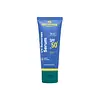What's inside
What's inside
 Key Ingredients
Key Ingredients

 Benefits
Benefits

 Concerns
Concerns

 Ingredients Side-by-side
Ingredients Side-by-side

Water
Skin ConditioningEthylhexyl Methoxycinnamate
UV AbsorberNiacinamide
SmoothingButyl Methoxydibenzoylmethane
UV AbsorberAluminum Starch Octenylsuccinate
AbsorbentPhenoxyethanol
PreservativeCetearyl Olivate
Propanediol
SolventButylene Glycol
HumectantOctocrylene
UV AbsorberAcrylates/C10-30 Alkyl Acrylate Crosspolymer
Emulsion StabilisingSorbitan Olivate
EmulsifyingPolymethyl Methacrylate
Aminomethyl Propanol
BufferingAllantoin
Skin ConditioningPanthenol
Skin ConditioningSalicylic Acid
MaskingXanthan Gum
EmulsifyingTriethylene Glycol
MaskingEthylhexyl Triazone
UV AbsorberTetrasodium EDTA
Lecithin
EmollientBHT
AntioxidantWater, Ethylhexyl Methoxycinnamate, Niacinamide, Butyl Methoxydibenzoylmethane, Aluminum Starch Octenylsuccinate, Phenoxyethanol, Cetearyl Olivate, Propanediol, Butylene Glycol, Octocrylene, Acrylates/C10-30 Alkyl Acrylate Crosspolymer, Sorbitan Olivate, Polymethyl Methacrylate, Aminomethyl Propanol, Allantoin, Panthenol, Salicylic Acid, Xanthan Gum, Triethylene Glycol, Ethylhexyl Triazone, Tetrasodium EDTA, Lecithin, BHT
Water
Skin ConditioningEthylhexyl Salicylate
UV AbsorberOctocrylene
UV AbsorberHomosalate
Skin ConditioningGlycerin
HumectantPropylene Glycol
HumectantNylon-12
Cyclopentasiloxane
EmollientBis-Ethylhexyloxyphenol Methoxyphenyl Triazine
Skin ConditioningGlyceryl Stearate
EmollientPolymethyl Methacrylate
Silica
AbrasivePhenoxyethanol
PreservativeCeteareth-20
CleansingCeteareth-12
EmulsifyingCetearyl Alcohol
EmollientCetyl Palmitate
EmollientSodium Laureth Sulfate
CleansingDimethicone/Vinyl Dimethicone Crosspolymer
Skin ConditioningAcrylates/C10-30 Alkyl Acrylate Crosspolymer
Emulsion StabilisingTriethanolamine
BufferingTriethylene Glycol
MaskingAminomethyl Propanol
BufferingHelianthus Annuus Seed Oil
EmollientPicea Mariana Bark Extract
AntioxidantEthyl Ferulate
AntioxidantRosmarinus Officinalis Leaf Extract
AntimicrobialTocopherol
AntioxidantEriophorum Spissum Flower/Stem Extract
Skin ConditioningWater, Ethylhexyl Salicylate, Octocrylene, Homosalate, Glycerin, Propylene Glycol, Nylon-12, Cyclopentasiloxane, Bis-Ethylhexyloxyphenol Methoxyphenyl Triazine, Glyceryl Stearate, Polymethyl Methacrylate, Silica, Phenoxyethanol, Ceteareth-20, Ceteareth-12, Cetearyl Alcohol, Cetyl Palmitate, Sodium Laureth Sulfate, Dimethicone/Vinyl Dimethicone Crosspolymer, Acrylates/C10-30 Alkyl Acrylate Crosspolymer, Triethanolamine, Triethylene Glycol, Aminomethyl Propanol, Helianthus Annuus Seed Oil, Picea Mariana Bark Extract, Ethyl Ferulate, Rosmarinus Officinalis Leaf Extract, Tocopherol, Eriophorum Spissum Flower/Stem Extract
 Reviews
Reviews

Ingredients Explained
These ingredients are found in both products.
Ingredients higher up in an ingredient list are typically present in a larger amount.
Acrylates/C10-30 Alkyl Acrylate Crosspolymer is a synthetic polymer. It is used to thicken and improve the texture of products. Due to its properties, it can prevent water and oil ingredients from separating.
Aminomethyl Propanol is used to adjust the pH of products. It is also used as a base to create other organic compounds. Having a balanced pH is important for protecting your skin.
Aminomethyl propanol is safe to use in cosmetics up to 1%. It is soluble in water.
Octocrylene protects skin from sun damage. It absorbs UV-B with peak absorption of 304 nm. It is a common sunscreen ingredient and often paired with avobenzone, a UVA filter. This is because octocrylene stabilizes other sunscreen ingredients by protecting them from degradation when exposed to sunlight. Octocrylene is a photostable ingredient and loses about 10% of SPF in 95 minutes.
Octocrylene also acts as an emollient, meaning it helps skin retain moisture and softens skin. It is oil-soluble and hydrophobic, enhancing water-resistant properties in a product.
Those who are using ketoprofen, a topical anti-inflammatory drug, may experience an allergic reaction when using octocrylene. It is best to speak with a healthcare professional about using sunscreens with octocrylene.
The EU allows a maximum of these concentrations:
Learn more about OctocrylenePhenoxyethanol is a preservative that has germicide, antimicrobial, and aromatic properties. Studies show that phenoxyethanol can prevent microbial growth. By itself, it has a scent that is similar to that of a rose.
It's often used in formulations along with Caprylyl Glycol to preserve the shelf life of products.
This ingredient is also known as PMMA. It is a polymer microsphere, composed of tiny, perfectly spherical particles formed from repeating units.
In cosmetics, PMMA is mainly used to give a soft or blurring effect. The transparent particles are able to scatter light and help reduce the appearance of fine-lines and imperfections.
PMMA is also able to enhance the texture of products by add a smooth feel.
Learn more about Polymethyl MethacrylateTriethylene Glycol is a fragrance.
Water. It's the most common cosmetic ingredient of all. You'll usually see it at the top of ingredient lists, meaning that it makes up the largest part of the product.
So why is it so popular? Water most often acts as a solvent - this means that it helps dissolve other ingredients into the formulation.
You'll also recognize water as that liquid we all need to stay alive. If you see this, drink a glass of water. Stay hydrated!
Learn more about Water